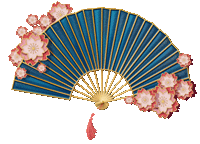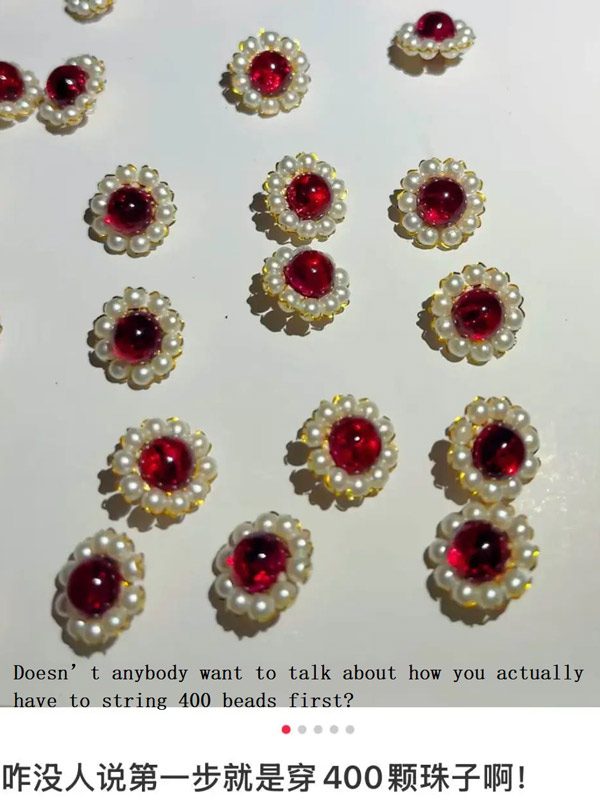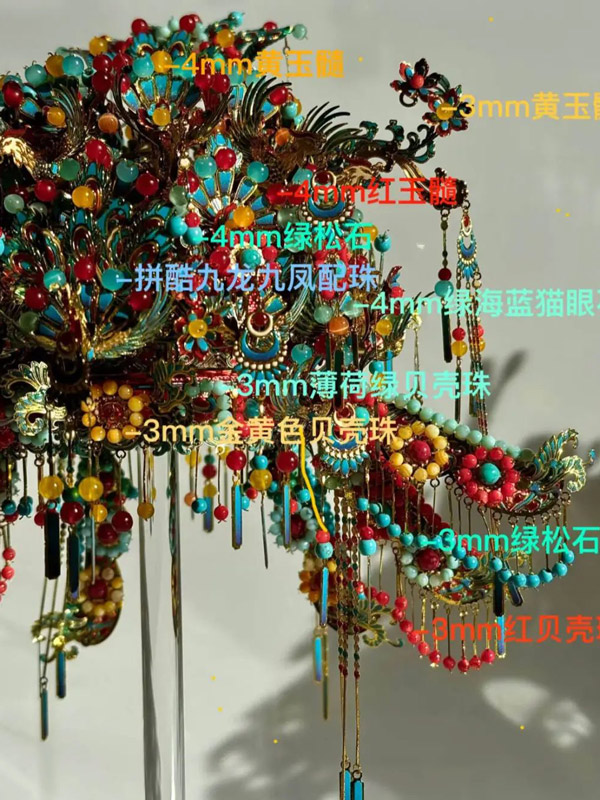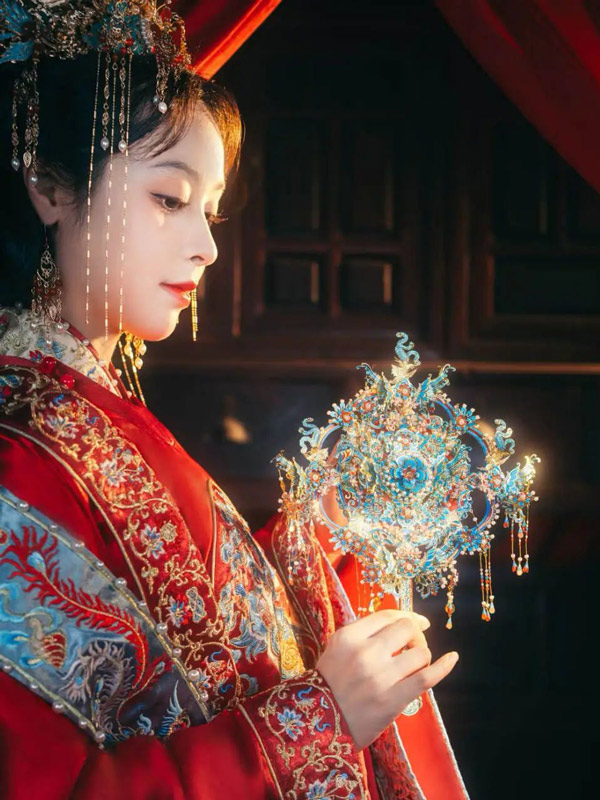"Wait... did Labubu just become queen?"
"Is this a coronation?"
This might sound like a fever dream to anyone unfamiliar with China's current toy scene, but yes—Labubu, the mischievous little vinyl gremlin from Pop Mart, is now the proud owner of a collection of handmade Chinese imperial crowns. We're talking intricate, blinged-out headdresses inspired by historical palace dramas like Empresses in the Palace—crafted not by costume designers, but by DIY-loving fans with way too much patience and a healthy dose of imperial obsession.
Let's back up.
 The Toy Queen Rises
The Toy Queen Rises
Pop Mart's Labubu has long been a favorite among Chinese collectors. But lately, the fandom has taken a sharp turn toward Qing dynasty cosplay. Why? Because someone, somewhere, realized the elaborate metal puzzle sets from a local brand called Piececool—originally marketed as romantic wedding-themed crafts—fit Labubu's rubbery little head perfectly. And when we say "elaborate," we mean hand-assembled metal pieces smaller than a pinky nail, forming full-on phoenix crowns (a traditional Chinese bridal accessory, often seen in palace dramas).
Can't afford the real Qing dynasty phoenix crown on display at the National Museum of China? No worries. Just spend ¥339 (about $45) and a few late nights, and you too can build your own doll-sized version. The irony? Many people couldn't even get their hands on the original toy figure (Labubu sells out fast), but they were still willing to drop serious time and money crowning someone else's Labubu. Welcome to the "la-fei" era—La Queen Labubu.
Once the first fan figured it out, it spread like wildfire on Chinese social media. On RedNote, the hashtag #labubu凤冠 (Labubu Phoenix Crown) became a full-on aesthetic. The vibe? "Old money Chinese royalty"—with dolls dressed in golden yellow robes and matching dragon-and-phoenix headpieces. The plush forest creature was reborn as a mini-emperor, or at least a mischievous palace concubine plotting her next move.
Some Labubus are clearly "emperor-coded"—think chubby orange robes and fur collars, like a forest version of Zhen Huan Zhuan's Emperor. Others go full empress: pearl-studded pink crowns, miniature sedan chairs, hand fans, lanterns, dowry chests—you name it. All to crown a figure that literally just stares at you with a toothy grin. And yet, that grin now feels... strategic. As if she's plotting who gets poisoned at the next palace banquet.
What's funny is that even the ones carrying the doll's flower sedan? They're Labubus too. Because if you're in the palace, you're either the queen or the labor.
And once your Labubu ascends the throne? There's no going back. The fandom is now deep into their own version of palace politics, complete with factions, rivalries, and, of course, different crown aesthetics. There's Nian La-Fei (with her blush pink gown and real pearls), and Ye La-Yi (with her cooler-toned silver crown and that "don't mess with me" side eye). Even though they're all still grinning, fans are convinced their smiles hide betrayal.
At this point, simply dressing up your doll in a custom outfit or buying a face protector mask (yes, that exists) feels basic. The DIY queens are now reenacting full palace arcs in miniature, with Labubu cast in every single role.
The most unexpected side effect? A spike in popularity for Piececool, the domestic brand that originally created these metal puzzles as romantic gifts. Back in 2018, their "Ten Miles of Red Bridal Attire" line included traditional wedding items like phoenix crowns, fans, and sedan chairs. It sold over 600,000 units in three years. But no one expected it to become this—a niche tool for DIY royal makeovers.
No one saw it coming. But once the first "royal Labubu" appeared online, the floodgates opened. Collectors who treated their dolls like their own kids weren't about to let them stay crownless. And so, an entire subculture was born: crafting, assembling, and crowning Labubu as if she's the lost heiress of the Qing dynasty.
Labubu may have started as a cheeky forest gremlin. But today? She's La-Fei, the empress of our hearts—and definitely our wallets.
 Building Mini Royalty
Building Mini Royalty
So, how did we get here?
How did a mischievous little vinyl toy end up with a full royal wardrobe and an army of fans handcrafting her imperial regalia?
Simple. Someone figured out that Piececool's "phoenix crown" puzzle sets—a whole series of intricately detailed metal headpieces originally meant as display models—fit Labubu's head just right. And from there, a new kind of collectible couture was born.
Now there's a crown for every Labubu mood: emerald-green cloisonné crowns (点翠凤冠), silver Miao-style crowns (非遗苗银冠饰), gold-winged crowns (金翅鸟冠), blue-and-white opera crowns (青花戏冠), bridal-style crowns (十里红妆凤冠), and even ultra-bling Nine Dragon Nine Phoenix sets (九龙九凤冠). Labubu isn't just a doll anymore—she's a full royal court.
And as with most niche hobbies in China, this got real expensive, real fast.
Azhu, a white-collar worker from Hangzhou, told me: "Sure, you can find knockoff versions for under ¥100 (about $13), but most 'doll moms' stick with Piececool." That's because it's become a status symbol—not just for Labubu, but for her human "staff." According to sales data from Piececool's official Tmall store, the best-selling emerald crown series has sold over 30,000 units. The individual emerald crown alone costs ¥339 ($45), with a strict 3-per-customer limit. And if you want the full set? ¥1754 ($240).
Azhu laughs: "It's giving 'too rich for my own Labubu.'"
But behind every empress is a broke fan—because none of this is pre-assembled. These crowns aren't just a splurge—they're a full-blown test of manual dexterity, sanity, and emotional endurance.
To make this high-end aesthetic slightly less ruinous, fans have developed their own hacks: waiting for livestream deals, or checking used goods marketplaces like Xianyu (basically Chinese Depop) for unfinished crown kits. "But even secondhand isn't that cheap," Azhu admits. "You're still paying at least ¥200 (~$28) for a proper crown."
And even after dropping that kind of cash, there's no guarantee Labubu will be crowned tonight.
That's because these crowns are, at the end of the day, 3D metal puzzle kits. In other words, you're building them yourself—hundreds of tiny, delicate parts, some of which require actual embroidery and beading. As Azhu puts it, "This is the kind of motherly love that depends entirely on your hands."
It starts with hope. And then chaos. For the emerald crown, you need to string together 400 beads—yes, four hundred—and stitch them into 40 tiny floral clusters before even touching the metalwork. Azhu spent her first night just on that step.
"Beading, threading, sorting pearls—I felt like I used up a lifetime's worth of fine motor skills in one evening," she joked.
People call it a stress-relieving craft. Azhu calls it survival mode.
And beading is only the beginning. Next, you build out the tail feathers for the phoenix, and then construct phoenixes—plural. Each side of the crown's base has to be individually adorned with a bird. Azhu spent four consecutive nights and ruined her hands twice before finishing just one crown.
"When was the last time my hands felt this wrecked? Never," she said. "I've never even made jewelry this detailed for myself."
And there's no guarantee it'll go smoothly. A single missing part can derail the entire build, like getting to the 99th step only to realize there's no 100th. "Parts go missing. Paint chips off. The whole thing is a gamble," Azhu said.
The gold-winged crown (made of brass) is a bit sturdier, but the most popular emerald crown is stainless steel—easier to damage, and prone to "dyeing" your fingers in weird metallic hues after a long night of handling.
Naturally, DIYers started getting creative. To up the glam and lower the risk of paint transfers, the latest trend is "bead swapping"—replacing the factory-color metal pieces with real beads or gemstones.
Because if you're going to suffer for your queen, you might as well make it sparkle.
 Status Games & Crown Mania
Status Games & Crown Mania
Back in April this year, tons of foreign fashion outlets declared Labubu the hottest accessory for 2025 bags. One sarcastic comment went viral: "Even Hermès is looking better now that it's hanging a Labubu charm."
But what those international fans don't realize is that in China's middle class, people have already started bedazzling Labubu's phoenix crowns with turquoise, yellow jade, cat's eye stones—you name it. Because apparently, no matter who you live with, life feels the same; but if you add some precious stones, suddenly it's a whole different vibe.
By day, these fans work for their bosses; by night, they work for Labubu. And they don't mind at all.
In 2024, the THE MONSTERS series—led by Labubu—raked in 3 billion RMB (about $450 million USD), boasting a mind-blowing growth rate of 726.6%. Yeah, you read that right.
But with great profits come great… hand cramps. Many fans admitted that assembling these metal puzzles feels like a form of "post-work torture." The frustration while building is real—yet once the final piece clicks in, and they see the delicate finished crown, they can't help but immediately order another one.
Some even ask: "Which crown is the hardest to assemble?"
The honest answer? "It doesn't matter. I just want my doll to have the best."
You start to get it—the magic of these metal crowns isn't just their craftsmanship, but the raw understanding of what those palace concubines were fighting tooth and nail for.
Mix the ancient aesthetic with that "old money" Chinese vibe, throw in a dash of political power fantasies, and suddenly, a phoenix crown is more than just an accessory for Chinese girls—it's a whole level of love, obsession, and status.
At first, fans tried "wearing" crowns virtually—snapping photos in front of the real ones at the National Museum of China, playing with light and angles to pretend they had the royal look. Then came the museum fridge magnet replicas, which were so popular you had to queue outside at 7 AM just to grab one.
Today, people spend four nights handcrafting actual miniature emerald crowns—but there's a catch: you can't wear them. They're tiny, delicate, and made of metal.
But where there's a will, there's a way. Fans still bask in the nostalgic glory of the noble Niohuru clan (a real Qing dynasty aristocratic family, here representing historical prestige) by displaying their painstakingly crafted crowns in acrylic cases or gifting them as wedding presents.
Can't wear the crown? No problem. There's also the fan.
These metal puzzle fans are just as intricate and just the right size to hold. They've carved out a niche as "realistic" collectibles: perfect for weddings, traditional photo shoots, or even just daily streetwear cosplay.
Apparently, the fans' cries for a "wearable life-sized phoenix crown" haven't gone unheard. At the end of last year, Piececool announced plans to launch a pink deluxe crown for adults in 2025, and you can already see mini versions in their stores. Pink and white, with the same exquisite luxury—the promo videos for this still-unreleased crown have racked up over 300,000 likes on social media.
The rumored price? Four figures. Yep, a real "life crown" with a serious price tag.
 Piececool's Crown Empire
Piececool's Crown Empire
It's amazing how this brand, Piececool, tied to wedding gear and now crowned Labubu's stylist, became the queenmaker of this toy fandom.
If you only know Pop Mart (the company behind Labubu) as the "trendy blind-box toy" brand, Piececool might sound unfamiliar. But it's actually a veteran player—its founder Ye Zufeng has been in the metal puzzle business for 21 years, and Piececool itself has been around for 11 years, just one year younger than Pop Mart.
Back in 2004, Ye started making metal assembly toys from ultra-thin stainless steel and brass sheets. At the time, Chinese consumers mainly thought of puzzles as Lego or kids' toys—metal puzzles were unheard of.
Selling trendy toys on the streets then? Ye joked that he probably made less than the uncle selling DVDs at the local market.
Back in the early days, Ye Zufeng, founder of Piececool, was stuck in the classic toy industry dilemma: selling didn't bring money, and profits were slim. So he took the usual route—targeting overseas markets, licensing foreign IPs, and doing OEM manufacturing (that's "original equipment manufacturer," basically building products for other brands).
By 2011, after years of trial and error, Ye partnered with an American company, handing over overseas operations and focusing on white-label production. Sounds fancy, but it's basically like owning a factory, hiring workers, then doing all the hard work for someone else's brand. Ye realized this was a dead-end. One late night, he probably just slapped his thigh and thought, "Enough—time to run my own show."
So in 2014, he parted ways with that US company and launched Piececool's own brand, shifting gears to explore China's traditional culture in new ways.
Coincidentally, 2015 became known as the "Year Zero" for China's IP economy. Dongguan, the country's biggest toy production hub, also started transforming. This city, famously home to some 4,000 toy companies and 1,500 supporting businesses, produces a whopping quarter of the world's anime-related merchandise. Industry insiders joke: "If Dongguan's roads are clogged, the whole world runs out of stock."
Take Shipaizhen (Shipaizhen), a small Lingnan town in Dongguan, for example. Since the 1980s, it's been cranking out OEM products for global toy brands. But by 2015, the rise of "chao wan" (潮玩, or "trendy toys") pushed many local makers to rethink their business models.
In 2016, Pop Mart signed its first exclusive IP—Molly. This shifted trendy toys from expensive collectibles into affordable items anyone could buy, sparking a craze that many didn't fully understand at first.
Piececool's own breakout moment took a few more years. In 2019, Ye and his team launched the "Ten Miles of Red Bridal Attire" metal puzzle series. It combined traditional Chinese wedding motifs with 3D metal modeling—and quickly sold over two million units, generating more than 400 million RMB (~$60 million).
This is where Labubu's phoenix crown comes from. Originally wedding-themed, but young people who aren't planning weddings repurposed it as a symbol of coronation—labubu's crowning glory. Azhu doesn't know who first had this brilliant idea, but suggests Piececool ship them a truckload of crowns as a thank-you.
China's Toy Factory Wins
The magic behind turning metal puzzles into Labubu's glimmering crowns lies in manufacturing upgrades—and Dongguan's industrial ecosystem played a huge role.
Wang Ning, Pop Mart's founder, pointed out that in 2016, Dongguan toy factories barely understood trendy toys. Their production capacity for these niche products was only 1%. Today, 70% of Dongguan's toy-making power supports Pop Mart.
Industry forecasts predict the trendy toy market will reach 110 billion RMB (~$16 billion) by 2026. Along with this boom comes supply chain upgrades—like the semiconductor tech behind the craftsmanship of "Ten Miles of Red Bridal Attire."
Since 2019, Piececool's annual sales have grown at a staggering 150% yearly pace, hitting 180 million RMB (~$26 million) in 2024. Meanwhile, Dongguan's trendy toy committee was founded in 2022 with Ye Zufeng as its first chairperson, and the city earned the title "China's Trendy Toy Capital" in 2023.
And amidst this whirlwind, Labubu remains the hottest name—selling out at 99 RMB ($14), while fans painstakingly assemble metal phoenix crowns priced at 339 RMB ($50), sometimes to the point of bleeding fingers.
Glance at the secondhand market—some finished crowns fetch over 500 RMB (~$75). Suddenly, you get why the character Jing Fei in Empresses in the Palace obsessively counts bricks. Behind those 400 beads lies the work of devoted "artisan moms."
That's the reality of Chinese parenting culture in miniature: "I'll suffer a little, but my Labubu must wear the shining phoenix crown that rules all."

 The Toy Queen Rises
The Toy Queen Rises









